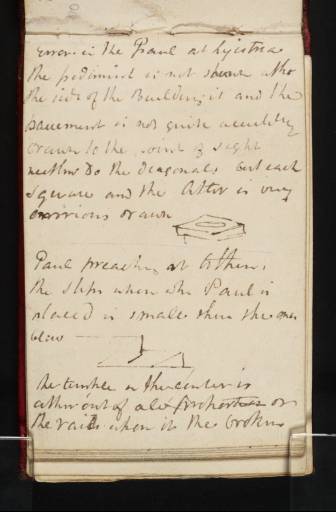These remarks are notes for Turner’s lectures as Professor of Perspective at the Royal Academy. In his lectures, he made extensive reference to Raphael’s tapestry cartoons, copies of which by Sir James Thornhill had been in the Academy’s collection since 1800 and hung in the Great Room at Somerset House where the lectures were given. For example in Lecture 1, on perspective and geometry, he discussed the use of perspective in the cartoons, which he felt was insufficiently appreciated.
1 In these notes, he is more critical. In the cartoon
St Paul and Barnabus at Lystra his objections are to the building in the distance whose portico is seen in a different perspective to its main block, to the pavement whose black and white slabs do not meet at the same vanishing point and to the altar whose top is seen in a shallower perspective. In
Paul Preaching at Athens he takes issue with the steps in the foreground and the round temple in the right background. Despite these strictures, in Lecture 6, ‘Backgrounds: Introduction of Architecture and Landscape’, Turner went on to praise Raphael’s use of parallel perspective to give grandeur to this subject, noting how ‘by means of the high horizon and the steps, only Paul possesses that elevation which, together with the simple yet energetic form, commands that attention ... which the nature of the subject demanded’.
2 A sketch of the figure, without the supporting steps, is Tate
D17139; Turner Bequest CXCV 168.

